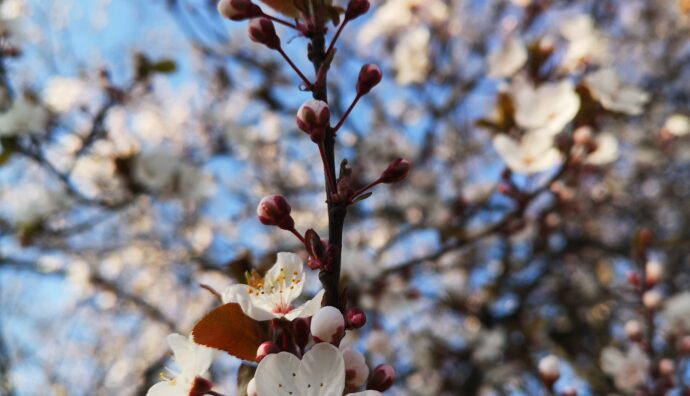The arrival of spring in Japan is celebrated with hanami (花見). The rebirth of nature, with the arrival of colors on the still bare branches, amazes everyone; in Japanese sensitivity and culture, spring triggers a social phenomenon in which a people recognizes themselves in contemplating the beauty of nature together.
There are real forecasts, like those about weather, which update the population about the advance from south to north of the “cherry front” (sakura zensen – 桜前線).
Thus the social ritual of hanami is identified with cherry blossom contemplation. Families gather in groups to organize picnics under the trees and stroll along the avenues that are painted with the shades of cherry blossoms.
A haiku by a great Japanese poet, Yosa Buson, says:
い 花 花
と に に
ま い 来
哉 ね て
ぶ
る
Hana ni kite / Hana ni ineburu /itoma kana
“I came for the flowers / And they made it hard / To say goodbye”
Faced with the weak, superb beauty of a flower, one cannot remain indifferent to the thought that the petals will soon fall and all the magnificent color palette of spring will soon disappear.
The flower, “that” flower that we observe and admire, will disappear. It will become a fruit and it too will vanish, leaving room for a seed. Which, if it doesn’t dissolve itself in the ground, won’t be able to make a new plant sprout.
We are so immersed in this thing we call “life” that we sometimes fail to shed some light on its mystery.
The cycles of nature can make us think that everything repeats itself. Yet, “that” flower has never been there before, nor, when it falls, will it ever return. It will become an ornament for a pot, food for a sparrow, a fruit that will enrich someone’s table in the summer, a plant that will make other flowers.
Yet that beauty is unique and unrepeatable. And it is destined to evolve into different forms, into new beauties. In new manifestations of life itself – even when the plant were to wither.
We believe that hanami is the essence of any discipline. A delicate attention to a kind of here and now that knows how to enjoy transitory beauty because it is aware that transience does not end in the despair of a vanishing youth. But it opens up to a wider life.
The here and now means “searching for the perfect flower” knowing that a well-groomed flower will eventually become a large tree that will give shelter and beauty to those who approach it. And that will multiply, perhaps in very distant future periods, the amazement, the search for the beautiful, the true, the authentic.
Looking for the perfect flower for yourself, as well as looking for the perfect technique without wanting to push yourself to understand what the evolutionary dynamics that the practice of the discipline can trigger, risks being a waste of time. Indeed, it can generate an involutionary spiral. Ultimately, getting intoxicated with the color of a bud alone can plunge you into the black despair of losing the value and meaning of what you do.
Bridging the gap between this sentence:
“The perfect blossom is a rare thing. You could spend your life looking for one and it would not be a wasted life”
and this one:
“Perfect. They’re all…perfect.” (Quote from “Last Samurai”)
well, s probably everyone’s task. In a dojo and outside a dojo. It doesn’t mean that every kind of technique will be acceptable. Nor that everything is to be accepted as it is, outside. However, probably it means that in every moment, no matter how beautiful, ugly, boring, tormented, inspired… Life flows powerfully in the same way. Always and forever.
And it is to this life that we are all called, in fullness. Looking for it in the humility of the often difficult physical work of exchanging techniques with a practitioner is a good way to honor our walking in a martial discipline.

